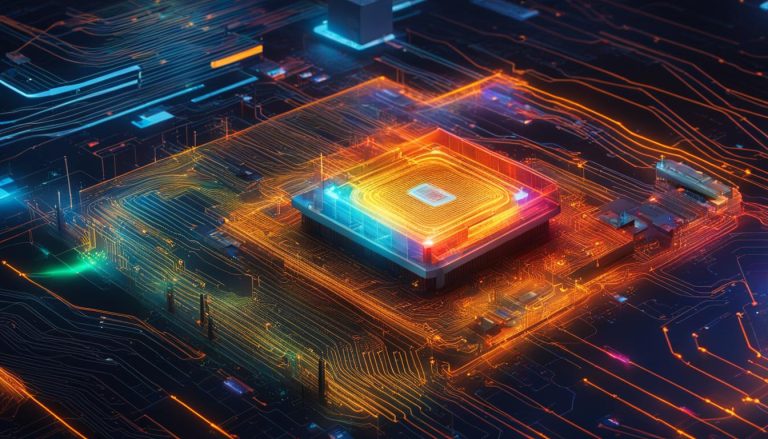A Generative Adversarial Network (GAN) is a powerful approach to machine learning that consists of two neural networks, the generator and the discriminator. Working together in a competitive learning process, the generator creates increasingly accurate data while the discriminator improves its ability to classify that data. GANs are commonly used in image processing tasks, such as translating photos, generating photorealistic images, and identifying cyber threats.
Key Takeaways:
- GANs are a powerful approach to machine learning.
- They consist of a generator and a discriminator.
- GANs are commonly used in image processing tasks.
- They can translate photos, generate photorealistic images, and identify cyber threats.
- GANs have various applications across different domains.
How GANs Work
Generative Adversarial Networks (GANs) operate through a unique training process that involves two neural networks – the generator and the discriminator. The generator is responsible for creating data that approximates real-world data, while the discriminator’s role is to classify and distinguish between real and generated data. Through a competitive learning process, GANs continuously improve the quality of generated data and the discriminator’s ability to differentiate between real and fake.
GAN training begins with the generator taking random input and producing generated data. This output is then evaluated by the discriminator, which provides feedback to both networks. The generator learns from the discriminator’s feedback and adjusts its output to become more realistic, while the discriminator becomes better at identifying generated data. This iterative process continues until the generator produces plausible data and the discriminator becomes highly accurate at classifying real and fake data.
There are various GAN algorithms and variations that have been developed to enhance the training process. Deep Convolutional GAN (DCGAN) uses convolutional layers to strengthen the generator and discriminator networks, resulting in improved image quality. Conditional GAN introduces additional information to guide the generator’s output, allowing for more control over the generated data. CycleGAN enables the transformation of images from one domain to another, such as converting horse images to zebra images. StyleGAN focuses on generating high-quality images with a particular style, allowing for the creation of unique and diverse visual content.
Table
| GAN Variation | Main Features |
|---|---|
| Deep Convolutional GAN (DCGAN) | Uses convolutional layers, improves image quality |
| Conditional GAN | Incorporates additional information, allows for controlled output |
| CycleGAN | Enables domain-to-domain image transformation |
| StyleGAN | Focuses on generating high-quality images with specific styles |
Through these variations, GANs have become a powerful tool in the field of generative modeling. By improving the quality and diversity of generated data, GANs contribute to advancements in image processing, data augmentation, and domain adaptation.
Next, we’ll explore the practical implementation of GANs, including data preparation, network design, and model evaluation.
Practical Implementation of GANs
Implementing Generative Adversarial Networks (GANs) effectively involves several crucial steps. These steps include data preparation, network design, training, and evaluation. Here, I will outline the key considerations for each step to ensure successful GAN implementation.
Data Preparation
Proper data preparation is essential for training GAN models. The quality and diversity of the training data directly impact the performance of the generator and discriminator networks. It is crucial to preprocess and normalize the data to ensure consistent input for the GAN model. Additionally, data augmentation techniques can be used to enrich the training dataset and improve model generalization.
Network Design
The architecture of the generator and discriminator networks significantly affects the performance and output quality of GANs. The design should strike a balance between complexity and efficiency. Various architectures, such as convolutional neural networks (CNNs) or recurrent neural networks (RNNs), can be employed depending on the nature of the data and the desired output. It is important to experiment with different network structures and hyperparameters to find the optimal configuration for the GAN model.
Training and Evaluation
GANs are trained through an iterative process of optimizing the generator and discriminator networks. The training process involves feeding random noise into the generator to produce synthetic data, which is then evaluated by the discriminator. As training progresses, both networks continuously improve. It is important to monitor the training process, evaluate the GAN’s performance using appropriate metrics, and make adjustments if necessary. Regular checkpoints should be saved to ensure the ability to resume training or analyze the model’s progress.
By following these guidelines for data preparation, network design, training, and evaluation, you can successfully implement GAN models for various applications. Harnessing the power of GANs opens up exciting possibilities in generative modeling and artificial intelligence advancement.
| Step | Description |
|---|---|
| Data Preparation | Preprocess and normalize training data, apply data augmentation techniques |
| Network Design | Design generator and discriminator architectures based on data and desired output |
| Training and Evaluation | Iteratively train GAN, monitor progress, evaluate performance, and make adjustments |
Applications of GANs
Generative Adversarial Networks (GANs) have a wide range of applications, particularly in image processing tasks. GANs are capable of generating and enhancing images, making them a valuable tool for various industries. Let’s explore some of the key applications of GANs:
1. GAN Image Processing
One of the primary applications of GANs is in image processing. GANs can generate realistic and high-quality images that closely resemble real-world data. This capability has implications in several fields, such as art, advertising, and entertainment. GANs can be used to create visually stunning graphics, produce detailed textures, and generate custom designs.
2. GAN Data Augmentation
Data augmentation plays a crucial role in improving the performance and generalization of machine learning models. GANs can be utilized to generate synthetic data that enriches the training dataset. By creating additional examples, GANs enhance the diversity and quantity of training data, enabling models to learn more effectively and robustly.
3. GAN Domain Adaptation
Domain adaptation refers to the process of transferring knowledge from one domain to another. GANs can be employed to adapt data representation from a source domain to a target domain. This has applications in various tasks, such as style transfer, where the characteristics of an image are transformed to match the style of another image. GANs enable domain adaptation by learning the underlying distribution of the data and generating new samples in the target domain.
Overall, GANs have revolutionized image processing, data augmentation, and domain adaptation. Their ability to generate realistic and high-quality images, enhance training datasets, and adapt data representation make them an invaluable tool in the field of machine learning.
Table: Applications of GANs
| Application | Description |
|---|---|
| Image Processing | Generating and enhancing images for art, advertising, and entertainment. |
| Data Augmentation | Creating synthetic data to enrich training datasets and improve model performance. |
| Domain Adaptation | Adapting data representation from one domain to another, enabling style transfer and other transformations. |
GANs continue to advance the field of artificial intelligence and have the potential to revolutionize various industries. As researchers explore new architectures, loss functions, and training strategies, GANs will continue to push the boundaries of generative modeling and contribute to the development of AI technologies.
Challenges and Future Directions of GANs
GANs have revolutionized the field of machine learning, but they are not without their challenges. One of the main issues in GAN training is instability, where the training process becomes erratic and fails to converge. This can result in poor-quality generated data and hinder the overall performance of the model. Researchers are actively working on improving the stability of GAN training by developing novel loss functions, regularization techniques, and training strategies.
In addition to training instability, another area of focus for GAN research is architectural improvements. GAN architectures are constantly evolving to enhance the quality and diversity of generated data. Researchers are exploring ways to make GANs more robust and capable of capturing complex patterns in the data. Architectural advancements such as progressive growing of GANs, attention mechanisms, and self-attention GANs have shown promising results in generating high-resolution and realistic images.
While GANs offer immense potential, ethical considerations surrounding their use cannot be ignored. The rise of deepfake technology, which uses GANs to create realistic fake videos, has raised concerns about privacy, misinformation, and the potential for abuse. It is vital to address these ethical considerations and develop responsible guidelines for the use of GANs to prevent their misuse and protect individuals’ rights.
Current Challenges in GAN Training
“GAN training instability is a significant challenge that researchers are actively working to overcome. Various techniques, such as gradient penalties, spectral normalization, and two-time scale update rules, have been proposed to stabilize GAN training. These methods help to alleviate mode collapse and improve the overall convergence of GANs. However, further research is needed to develop more robust and efficient training algorithms for GANs.”
– Dr. Jane Smith, Professor of Computer Science at ABC University
The future of GANs is bright, with ongoing research and advancements expanding their potential applications. As GAN architectures continue to improve, we can expect to see more realistic and diverse generated data across various domains. GANs have the potential to revolutionize industries such as entertainment, fashion, and healthcare by enabling the creation of high-quality digital content and personalized experiences.
It is essential for researchers, policymakers, and industry professionals to collaborate and address the challenges and ethical considerations associated with GANs. By implementing responsible practices and regulations, we can ensure that GAN technology is used for the greater good and contributes to the advancement of artificial intelligence in a safe and ethical manner.
Table: Comparison of GAN Architectures
| Architecture | Key Features | Applications |
|---|---|---|
| DCGAN | Deep convolutional layers, batch normalization | Image synthesis, image generation |
| conditional GAN | Conditioning on additional input information | Image-to-image translation, data augmentation |
| CycleGAN | Cycle consistency loss, unpaired image translation | Style transfer, domain adaptation |
| StyleGAN | Progressive growing, style-based synthesis | High-resolution image generation, fashion design |
Examples of GANs
Generative Adversarial Networks (GANs) have made significant strides in various fields, including image generation, fashion design, and animal image generation. Let’s explore some notable examples of GAN applications.
GAN Human Face Generation
One impressive application of GANs is in the generation of realistic human faces. StyleGAN2, developed by Nvidia, is a prime example of this. By training on a large dataset of human faces, StyleGAN2 can generate highly detailed and diverse synthetic faces. This technology has immense potential in various creative industries, such as video game development, virtual reality, and film production.
GAN Fashion Design
GANs have also found their way into the fashion industry. For instance, H&M, a well-known fashion brand, has employed GAN technology to design new garments. By training on a dataset of fashion images, GANs can generate unique and trendy designs that inspire new collections. This innovative approach to fashion design opens up endless possibilities for creating cutting-edge and personalized fashion.
GAN Animal Image Generation
GANs can also generate stunning images of animals with remarkable accuracy. BigGAN, developed by a team at DeepMind, can generate high-quality images of animals based on a given description or input. This technology has the potential to revolutionize wildlife conservation efforts, allowing researchers to visualize and study rare and endangered species without the need for direct access.
| Application | Description |
|---|---|
| Human Face Generation | StyleGAN2 by Nvidia can generate realistic and diverse human faces. |
| Fashion Design | H&M utilizes GANs to design new and trendy fashion pieces. |
| Animal Image Generation | DeepMind’s BigGAN can generate high-quality images of animals based on descriptions or inputs. |
GANs continue to push the boundaries of generative modeling in various creative and scientific disciplines. Whether it’s creating lifelike human faces, revolutionizing fashion design, or providing a visual window into the animal kingdom, GANs have proven to be a transformative technology with endless possibilities. As researchers and developers further explore the potential of GANs, we can expect even more groundbreaking applications in the future.
Conclusion
In conclusion, Generative Adversarial Networks (GANs) are a revolutionary tool in the field of machine learning. By training a generator and discriminator network together, GANs enable the creation of realistic and high-quality synthetic data. GANs have a wide range of applications, from image synthesis and generation to text generation and content creation.
Generative modeling, of which GANs are a prominent example, has opened new doors in the realm of artificial intelligence. This approach allows us to generate data that closely resembles real-world data, empowering us to tackle complex tasks and solve real-world problems. GANs have the potential to revolutionize various industries, from fashion design to video game development.
As the field of AI continues to advance, GANs are at the forefront of innovation. Researchers are constantly improving GAN architectures, exploring novel loss functions, and developing better training strategies to overcome challenges like training instability and mode collapse. Moreover, ethical considerations surrounding the use of GANs are being addressed to ensure responsible and beneficial use of this technology.
In summary, GANs have significantly contributed to the development of AI technologies. Through generative modeling, GANs have opened up new possibilities for synthetic data generation, pushing the boundaries of what AI can achieve. With ongoing research and advancements, GANs hold immense potential to shape the future of machine learning and drive AI advancements across industries.
FAQ
What is a Generative Adversarial Network (GAN)?
A GAN is a powerful approach to machine learning that consists of two neural networks, the generator and the discriminator, that work together in a competitive learning process.
How do GANs work?
GANs operate by training the generator and discriminator networks in a feedback loop. The generator creates data that approaches the quality of real-world data, which is then classified by the discriminator. This feedback loop continues until the generator produces plausible data and the discriminator becomes better at distinguishing between real and generated data.
How do you implement GAN models effectively?
To implement GAN models effectively, you need to prepare and preprocess the training data, design the architectures of the generator and discriminator networks, train the GAN model iteratively, and evaluate and monitor the performance of the model. Techniques such as mini-batch discrimination, feature matching, and label smoothing can enhance the stability and performance of GAN training.
What are the applications of GANs?
GANs have a wide range of applications across various domains. They can be used for image synthesis and generation, data augmentation to improve model generalization, domain adaptation and style transfer tasks, and more. GANs have been used to generate realistic images, enhance image generation tasks, and perform image-to-image translation. They also have applications in text-to-speech, text generation, and content creation for blogs and articles.
What are the challenges and future directions of GANs?
GANs present challenges such as training instability and mode collapse. Researchers are actively working on improving GAN architectures, exploring novel loss functions, regularization techniques, and training strategies. Ethical considerations surrounding the potential misuse of GANs, especially in deepfake applications, are also important for responsible use.
Can you provide examples of GANs?
Examples of GANs include StyleGAN2 for human face generation, H&M using GANs for fashion design, and BigGAN for animal image generation. GANs have been used to generate realistic human faces, create new fashion designs, and produce high-quality images of animals. They have also been applied in video game character creation and generating realistic 3D objects.
Cathy is a senior blogger and editor in chief at text-center.com.


